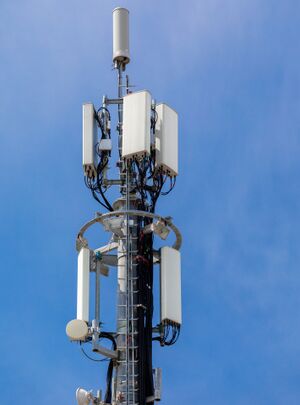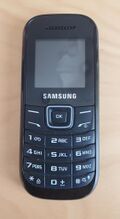Cellular communications
Introduction
As mobile phone density has increased world wide, cellular communications have been increasingly reached for during an environmental disaster, wartime, and other crises. However, like any powered infrastructure, this communications technology is vulnerable to blackouts. Further, cell tower (or 'cell site') base stations and repeaters are dependent on the integrity of the structure to which they are affixed, and so as vulnerable to the effects of storms, earthquakes and floods as the building or radio mast to which they are attached.
This page will look at the disaster tolerance of cellular communications, detail work done to improve reliability in a crisis situation, and provide solutions implementable and maintainable by communities in service to their own needs, providing inexpensive low-power wide-area mobile phone telephony.
Anatomy of a cell tower

Antennae, and the equipment comprising a cellular base station, are typically mounted onto a radio mast, or other raised structure, like a building. Sometimes the structure is disguised as other things, like a tree, or as bricks, so as to blend in with the local environment.
A cell tower acts as a single 'cell' within a network of other inter-connected cells, allowing for the seamless registration and migration of handsets (mobile phones) from cell to cell as they move across the geography. This inter-connection with neighbouring cell sites is done with the application of a dedicated point-to-point directional antenna (focused radio 'beams' transmit and receive along one direction) known as a remote radio head. These special antenna typically transmit and receive on microwave (sub-millimeter wavelength bands). The other directional antennae on a cell tower is typically of the flat-panel type, are for traffic to-and-fro handsets.
One way to tell the difference between phone-facing and cell-facing antennae in a dense urban environment is that the surface of the remote radio head is typically perpendicular to the ground (pointing to another cell site), whereas the directional antenna facing phones is angled slightly downward, for instance to a road or street. Remote radio heads are also often round, with a flat surface like a drum (as shown in this section's photograph). The antennae are all connected to their respective individual base stations, often housed inside rigid plastic weatherproof boxes, and connected to the local electricity grid. Sometimes the base stations are hidden within the tower structure, or in a dedicated structure built at its base.
In some cases the cell tower will have redundant power supply in the form of a battery array or generator. Generators are often diesel, with a large tank of diesel supply.
Multiple providers will often mount their equipment to the same structure, sharing the rates and lease cost presiding over the structure.
Standards
At the current time there are two dominant cellular communications systems in use: CDMA (used primarily throughout the United States, South Korea and Japan) and GSM, which is used everywhere else, also including some parts of the United States.
Use of cellular infrastructure in disasters
As mobile phone adoption has rapidly increased, so has cellular communications infrastructure spread. In many parts of the developed world cell sites provide coverage across the majority of the landscape, whereas in economically poorer regions mobile data increasingly acts as the sole means of internet access in urban and rural areas.
Due to this broad use, cellular communications are increasingly used as a broadcast medium for alerting as to a coming extreme environmental event. Further, during the preparation phase, the event phase and aftermath, cellular phones are often used to organise, stay in touch with loved ones and to give location and status updates to rescue teams. The use of realtime video and the sharing of photos and voice messages has proved vital for rescue efforts across many disaster events.
Failure of cellular infrastructure during disaster events
Cellular infrastructure has a long history of failing civilians when needed most. In some cases it has been due to infrastructure itself being damaged, whereas in others the network has been overloaded to the point of becoming unusable. When extreme events result in the disruption or blackout of communications systems, uncertainty and anxiety is often amplified hampering relief efforts[1].
Three causes of cellular communications failure[2][3]:
- Destruction of CS components
- Damage of supporting infrastructure
- Congestion
Hurricane Katrina (2005) saw communication infrastructure broadly damaged, resulting in challenges for thousands of victims and many first response teams[4], whereas in the Fukashima disaster of 2011, the network became almost immediately overloaded and unusable. In this latter case, untrained and unprepared taxi drivers quickly came to the aid using traditional in-vehicle CB transceivers to relay information and coordinate relief efforts. In the 2010 Haiti earthquake, radio again played a mission-critical role where cellular networking failed due to damage and/or overloading[5]. In the 2023 Cyclone Gabrielle hit the North Island of New Zealand 10s of 1000s of people uncontactable due to communications infrastructure being without power, and whose battery fallback only lasted a few hours and where due to the remote location of the infrastructure it was not possible to supply power via transported diesel generators[6].
Where radio is used, status updates and information relaying rely on language comprehension parity, and so in some cases human translators, and also lack the benefit of images and video to provide status information. Further, rarely are victims of disasters carrying 2-way radios like walkie-talkies [7] or personal locator beacons (PLBs)[8].
Sometimes however, even in cases cellular communications are available, or have been partially restored, internet access itself is not available via mobile data routing. This is due to the 'backhaul' connections being broken or impaired. In both Haiti's 2010 earthquake and Eastern Japan's 2011 earthquake, submarine cables were severely damaged, cutting off large populations from the Internet[9]. This serves as an example where the use of Internet-dependent remote 3rd party applications or services on phones is not always to be relied upon.
Failure of mobile phones during disaster events

While modern smartphones provide many conveniences, much of their functionality is dependent on network connectivity. When mobile data or WiFi is unavailable, the device's use is limited to the on-phone features and applications that do not need Internet access. A common issue with smartphones in a disaster event is that they run out of battery, and so may not be usable into the 2nd day of an event. Another is that they suffer water or impact damage. For this reason it is wise to put your smartphone into low power mode early into a disaster event while disabling WiFi and any unnecessary idling applications. A ziplock bag can also protect your phone from water damage. When putting it into your go-bag, make sure it is easily accessible but also protected from impact damage where possible.
It is also good to have a fallback phone solely for texts and calls. This can be a very inexpensive 'dumbphone', many of which have battery life counted in several days, even weeks.
Community operated cellular infrastructure

Often it is victims of environmental and other disasters that are geographically closest to the damaged cellular communications infrastructure they depend upon, and yet even with sufficient knowledge at hand, civilians may not have the rights, credentials and rarefied tooling to attempt a repair that involves access to the base station component itself.
It is here that community owned and operated cellular infrastructure presents an interesting fallback where technical ability allows. A cell tower capable of providing voice and messaging for a remote or at risk community can be implemented using a Software Defined Radio (SDR), an open source software stack, a laptop or mini computer (like a Raspberry Pi) and flat panel directional antennae designed for a GSM band.
- YateBTS [10]
- BladeRF [11]
- 2x GSM 900 or GSM 1800 directional antennae
- LNA
- Power amplifier
- Coaxial cable and connectors
A pre-packaged example implementation of this is Pink Cell Tower by technologist and artist Julian Oliver and contributor to this wiki<ref>https://julianoliver.com/projects/pink-cell-tower/<ref>. An entire pre-configured 'ISO' disk image can be downloaded and flashed onto an SDcard, for use on a Raspberry Pi minicomputer that is connected to a BlareRF SDR, in turn connected to directional antennae on its transmit (TX) and receive (RX) ports. Optionally running from a truck batteries powered by solar panels, the project can also serve a simple website on the Raspberry Pi 4's built-in WiFi device, whereby important information can be served to those physically proximate to the tower itself.
It is important to check your local jurisdiction before setting up a cell site, as doing so is often in breach of local radio frequency allocation and usage laws. In an emergency such strictures may matter very little.
Citations
- ↑ https://journals.sagepub.com/doi/full/10.1177/1550147719829960M
- ↑ https://ieeexplore.ieee.org/document/6103680
- ↑ Menon VG, Pathrose JP, Priya J. Ensuring reliable communication in disaster recovery operations with reliable routing technique. Mob Inf Syst 2016; 2016: 9141329.
- ↑ https://www.researchgate.net/publication/242196608_The_Impact_of_Hurricane_Katrina_on_Communications_Infrastructure
- ↑ http://www.aidforum.org/topics/mobile-for-development/the-use-of-mobiles-in-disasters/
- ↑ https://www.rnz.co.nz/news/national/485259/why-nz-s-communications-networks-broke-down-in-cyclone-gabrielle
- ↑ Radio, Collapsible Wiki
- ↑ https://en.wikipedia.org/wiki/Emergency_position-indicating_radiobeacon
- ↑ https://journals.sagepub.com/doi/full/10.1177/1550147719829960#table1-1550147719829960
- ↑ https://yatebts.com/
- ↑ https://www.nuand.com/bladerf-1/